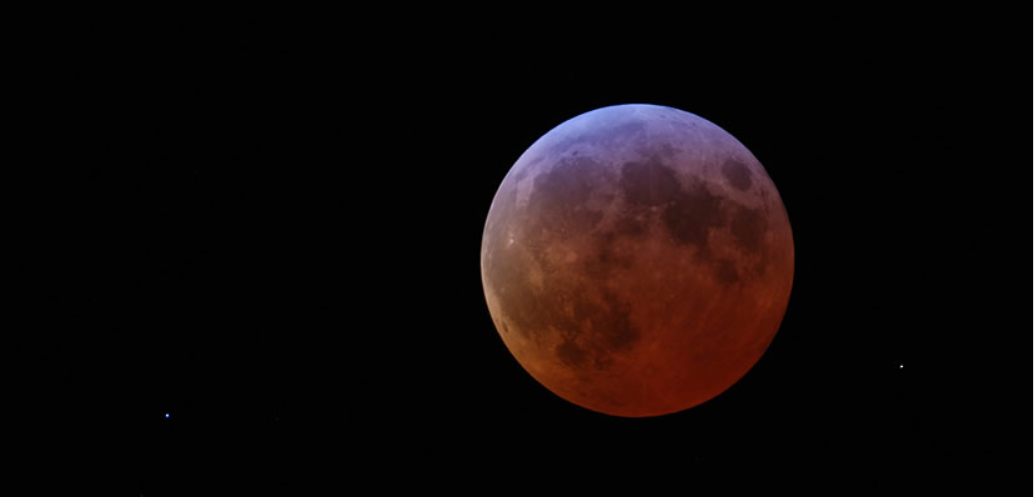Eclipse & Airlight, Chile - OPOD
Eclipse & Airlight, Chile - OPOD: A Captivating Display of Atmospheric Optics
The captivating phenomenon of a total lunar eclipse never fails to mesmerize observers around the world. One such breathtaking event was captured by Yuri Beletsky on September 28, 2015, from the Carnegie Las Campanas Observatory in the picturesque Atacama Desert, Chile. The image reveals the moon shrouded in Earth's shadow, with a stunning display of colors on its edges. This celestial spectacle not only showcases the beauty of the eclipse but also offers a fascinating glimpse into the interplay between light and Earth's atmosphere.
As we marvel at the eclipse, it is essential to recognize the significant role played by Earth's atmosphere in shaping the visual experience. While the shadow cast by our planet is responsible for the moon's dimming during an eclipse, there is more to the story. Another layer of Earth's atmosphere adds its own touch of color to the eclipsed moon. This phenomenon becomes apparent as we observe the edge of the coppery shadow, adorned with hues of blues and purples. These captivating shades are a result of the interaction between sunlight and the ozone layer in the stratosphere.
During an earlier eclipse, Eva Seidenfaden (paraselene) captured a stunning scene that showcases this atmospheric phenomenon. The interplay between Earth's shadow and the ozone layer creates a unique visual spectacle, with the moon adorned in a tapestry of colors that adds to the mystique of the eclipse.
To fully appreciate the intricacies of this atmospheric optics phenomenon, it is important to understand the role played by ozone. Ozone, a molecule composed of three oxygen atoms, is primarily located in the stratosphere. As sunlight passes through this layer, it undergoes a process called absorption. The ozone molecules absorb certain wavelengths of light, particularly in the blue and purple regions of the spectrum. This absorption leads to the filtering out of these colors, resulting in the distinctive hues observed during an eclipse.
The presence of ozone in the stratosphere not only contributes to the enchanting colors of an eclipse but also serves a vital role in protecting life on Earth. The ozone layer acts as a shield, absorbing a significant portion of the sun's harmful ultraviolet (UV) radiation. Without this protective layer, life on our planet would be exposed to excessive levels of UV radiation, posing serious health risks and disrupting ecosystems.
As we witness the captivating display of colors during a lunar eclipse, it is a reminder of the interconnectedness of Earth's systems. The interplay between light, the atmosphere, and celestial bodies creates a harmonious dance that leaves us in awe. It is a testament to the beauty and complexity of our planet and the universe at large.
In conclusion, the images captured during the total lunar eclipse in Chile offer a glimpse into the mesmerizing world of atmospheric optics. The interaction between Earth's shadow and the ozone layer in the stratosphere creates a breathtaking display of colors on the edge of the eclipsed moon. This phenomenon highlights the role played by Earth's atmosphere in shaping our visual experiences and protecting life on our planet. As we continue to explore and understand the wonders of atmospheric optics, let us marvel at the intricate beauty of nature's phenomena that unfold before our eyes.


Earth's Atmosphere Near & Far
Yuri Beletsky captured last Monday's (28 September '15) total lunar eclipse from Carnegie Las Campanas Observatory in the Atacama Desert, Chile. Scroll right for the larger image.
Image ©Yuri Beletsky, shown with permission

Another layer of Earth's atmosphere also colours the eclipsed moon. Here the edge of the coppery shadow is hued with blues and purples. They are from absorption by the layer of ozone in the stratosphere.
Eva Seidenfaden (paraselene)pictured this scene during an earlier eclipse.
Note: this article has been automatically converted from the old site and may not appear as intended. You can find the original article here.
Reference Atmospheric Optics
If you use any of the definitions, information, or data presented on Atmospheric Optics, please copy the link or reference below to properly credit us as the reference source. Thank you!
-
<a href="https://atoptics.co.uk/blog/eclipse-airlight-chile-opod/">Eclipse & Airlight, Chile - OPOD</a>
-
"Eclipse & Airlight, Chile - OPOD". Atmospheric Optics. Accessed on April 25, 2024. https://atoptics.co.uk/blog/eclipse-airlight-chile-opod/.
-
"Eclipse & Airlight, Chile - OPOD". Atmospheric Optics, https://atoptics.co.uk/blog/eclipse-airlight-chile-opod/. Accessed 25 April, 2024
-
Eclipse & Airlight, Chile - OPOD. Atmospheric Optics. Retrieved from https://atoptics.co.uk/blog/eclipse-airlight-chile-opod/.